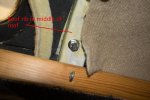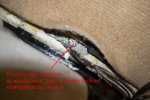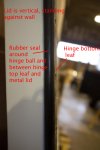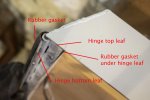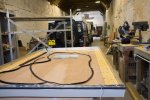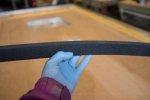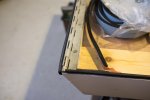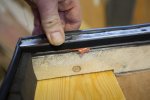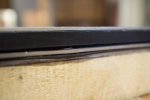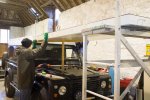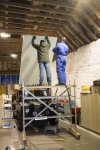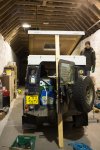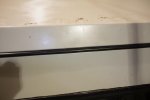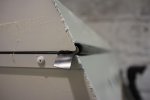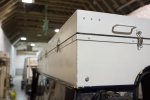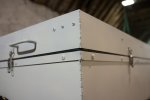Have made a decision about the seals. I found the following rubber profile which ironically is a part for a LandRover door but available off-the-roll from seal suppliers. Its a simple flap with a pre-formed curl. Wall thickness is around 2mm.
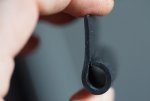
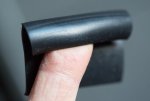
The idea is that I can use this above the top leaf of the hinge. This will both seal the hinge/roof join and the 'curl' is perfect to go around the hinge ball, effectively sealing it from blowing water coming in.

It is supple enough that when the lid is opened it will bend with the hinge and maintain the seal.
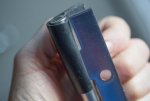
On the lower hinge/body interface I can put a simple flap of 25mm x 1.5mm rubber that will extend out to touch the curled over section to provide a reasonable join. Neoprene strip inserted in between the hinge (ie over the top of the screws) will seal it when closed, as it will be 'pinched' and under pressure from the closed hinge.
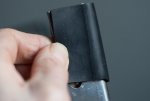
And of course this has raised the lid by the thickness of the curl section - 2mm, plus the flap on the lower hinge another 1.5mm, so that's a total of 3.5mm to 4mm. This has meant that I need a slightly thicker seal on the other three edges around the roof and I found an 8mm 'tadpole' section that is perfect. It's actually got a manufacturing defect and this has resulted in the flange being off-centre so that the gap on one side is 2.5mm and on the other is 3.5mm instead of being central. This has meant I can use it for my 3mm section and it wont protrude beyond the face of the top section when not under pressure, and will therefore be clear of the clips when it comes down. I've kept the clips slightly above the surface of the lower lip of the roof to use as stops/guides for the raising/lowering section as you can see here in a previous post.
I estimate when its under pressure the tadpole will deform to 'lose' its hollow in the middle part of the roof (but only half deform at each end of the roof given the 'banana' shape I'm working to alleviate/seal) and so will end up raising the lifting lid by twice the seal wall thickness of approx 2mm = so around 4mm total. Which is pretty much what the hinge rubbers at the front raise the lid by given their thicknesses. Of course the only way to find out for sure if all this works in practice is to do it! Does all that make sense? Basically I'm having to take into account the deformation of the main seals around the three sides, and what thickness they end up when under pressure, and then that precise amount will be the gap at the hinge that needs sealing, split into two separate seals, one above and one below the hinge. Clear?
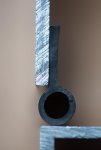 but
but
Van is now temporarily in a friend's dry barn/workshop with 18 feet of overhead space - I need 16 feet to raise my roof to vertical to fasten the hinge so its a perfect space. Hopefully will have the roof fastened down, sealed, lid and hinges fixed and seals on, gas struts fitted in the next few weeks if it all goes to plan. (fingers crossed!))


The idea is that I can use this above the top leaf of the hinge. This will both seal the hinge/roof join and the 'curl' is perfect to go around the hinge ball, effectively sealing it from blowing water coming in.

It is supple enough that when the lid is opened it will bend with the hinge and maintain the seal.

On the lower hinge/body interface I can put a simple flap of 25mm x 1.5mm rubber that will extend out to touch the curled over section to provide a reasonable join. Neoprene strip inserted in between the hinge (ie over the top of the screws) will seal it when closed, as it will be 'pinched' and under pressure from the closed hinge.

And of course this has raised the lid by the thickness of the curl section - 2mm, plus the flap on the lower hinge another 1.5mm, so that's a total of 3.5mm to 4mm. This has meant that I need a slightly thicker seal on the other three edges around the roof and I found an 8mm 'tadpole' section that is perfect. It's actually got a manufacturing defect and this has resulted in the flange being off-centre so that the gap on one side is 2.5mm and on the other is 3.5mm instead of being central. This has meant I can use it for my 3mm section and it wont protrude beyond the face of the top section when not under pressure, and will therefore be clear of the clips when it comes down. I've kept the clips slightly above the surface of the lower lip of the roof to use as stops/guides for the raising/lowering section as you can see here in a previous post.
I estimate when its under pressure the tadpole will deform to 'lose' its hollow in the middle part of the roof (but only half deform at each end of the roof given the 'banana' shape I'm working to alleviate/seal) and so will end up raising the lifting lid by twice the seal wall thickness of approx 2mm = so around 4mm total. Which is pretty much what the hinge rubbers at the front raise the lid by given their thicknesses. Of course the only way to find out for sure if all this works in practice is to do it! Does all that make sense? Basically I'm having to take into account the deformation of the main seals around the three sides, and what thickness they end up when under pressure, and then that precise amount will be the gap at the hinge that needs sealing, split into two separate seals, one above and one below the hinge. Clear?
 but
but Van is now temporarily in a friend's dry barn/workshop with 18 feet of overhead space - I need 16 feet to raise my roof to vertical to fasten the hinge so its a perfect space. Hopefully will have the roof fastened down, sealed, lid and hinges fixed and seals on, gas struts fitted in the next few weeks if it all goes to plan. (fingers crossed!))
Last edited:



